
Sterling Silver Duck Head Walking Cane
A fine walking cane, ebonized bamboo shaft with sterling silver duck head handle with glass eyes, 19th century, 82 cm high

Sterling Silver Walking Stick with Concealed Pencil
A walking stick, cane shaft with sterling silver collar and cap, also fitted with concealed pencil, 90 cm high

Hardy Brothers Sterling Silver Walking Cane Cap
Vintage sterling silver capped walking cane cap marked sterling for Hardy Brothers, monogrammed, to wooden walking stick, with brass ferrule to base, length 90 cm.

Gold-handled Canes from C&S, c. 1900
Pair of gold handled canes, mark of C&S., c. 1900, each ebonised tapering stick with 18 carat yellow gold capped handle (2), length 90 cm. Provenance: The Collection of Janet and Graeme Webb, Wollogorang, NSW

Sydney Engraved Brass Banded Walking Cane
Vintage brass banded wood walking cane brass band engraved 'Sydney,' brass tip, length 85 cm approx.
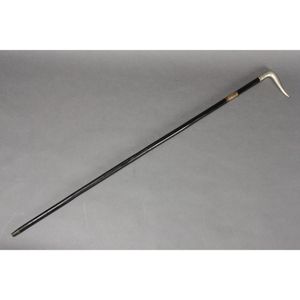
Curved Handle Cane Sword Stick
Late 19th century cane sword stick, with curved metal handle above ebonised case, with sword stick inside, length 94 cm
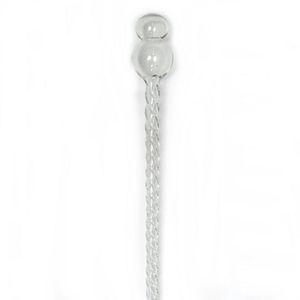
Victorian Clear Glass Walking Cane with Spiralling Shaft
A Victorian hollow blown glass walking cane whimsey, in clear glass with bulbous head and spiralling shaft. 148 cm.
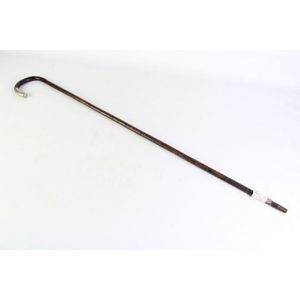
Victorian Sterling Silver Topped Walking Cane - 91cm
Hallmarked sterling silver topped Victorian walking cane length 91 cm
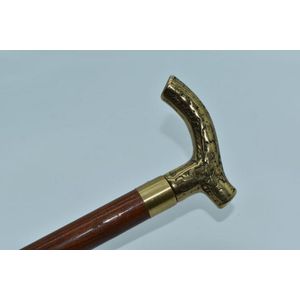
Brass-handled walking cane with hidden flask
Vintage gentleman's walking cane with ornate brass handle, hidden flask (collapsible)
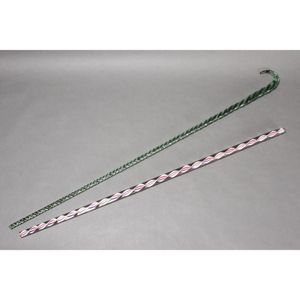
Antique Glass Walking Canes - Green Twist & Swirl Cane
Two antique glass walking canes, including green twist glass cane, length 99 cm, and red, white and blue swirl cane, a/f, 87 cm (2)

Brass-Mounted Malacca Walking Stick with Dog Head
A dog head carved malacca cane walking stick, c.1900, in brass decorative mount with vacant cartouche, length 83.5 cm.
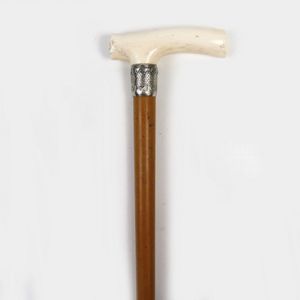
Monogrammed Ivory Handle Walking Stick
A vintage walking stick, the Malacca cane shaft fitted to a monogrammed ivory handle and embossed silver plate collar, length 86 cm

Ivory and Silver Gilt Walking Cane - Late 19th Century
A late 19th century ivory and silver gilt walking cane the shaft of slim proportions and featuring a small finely decorated hallmarked silver top, length 94 cm

Silver Horse Leg Walking Cane
A Victorian walking cane, the tapering wood shaft terminating with a silver plate horse leg handle.

Silver and Ivory Gentleman's Walking Cane
19th century gentlemans walking cane with silver collar and ivory top

19th Century Gold Cap Walking Cane with Carved Snake
An impressive walking cane with gold cap engraved 'J.S.N. of Lethane', with carved snake chasing a frog, housed in original fitted case, 19th century, 92 cm high
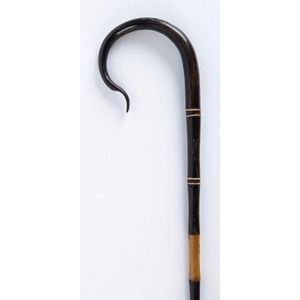
19th Century Horn and Ivory Shepherd's Crook Walking Cane
A shepherds crook walking cane, horn ivory and baleen with brass ferrule, 19th century, 84 cm high
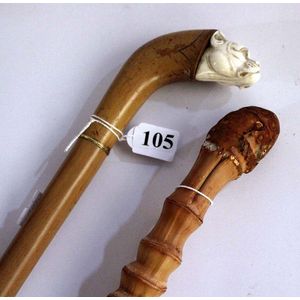
Australian Walking Sticks with Bone Dog Handle and Cane
Two Australian early 20th century walking sticks, one with carved bone dog handle and with gold collar, the other of cane. Length 86, 94 cm.

Victorian Ivory Walking Stick with Elephant and Lion Handle
A Victorian all ivory walking stick, assembled in ten screw pieces, with cane carved shaft, the ivory handle carved as elephant head and lion head. Length 89 cm.
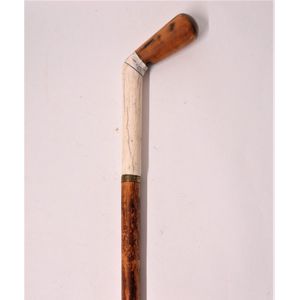
Malacca Cane and Bone Walking Stick
A vintage malacca cane and bone walking stick, the lower handle of plain turned tapered cylindrical bone section, brass collar to the malacca cane shaft. Length 91 cm.

Malacca Cane & Horn Walking Cane
Vintage Malacca cane & horn walking cane, horn handle, with Malacca cane body, (length 89 cm).

Ornate Indian Silver Grip on Victorian Malacca Cane
Victorian Malacca cane, with Indian silver ornately embossed grip
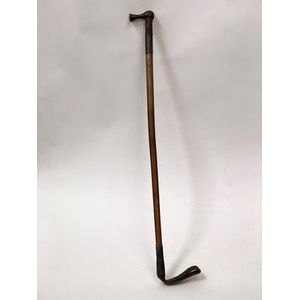
Sterling Silver Victorian Riding Crop and Walking Cane
Victorian riding crop, with sterling silver collar & walking cane

George V Silver Topped Walking Cane
George V sterling silver topped walking cane Birmingham 1922, silver capped, some dents, to coromandel cane, length 91 cm

Art Deco Ivory Walking Stick with Exotic Wood Shaft
French Art Deco ivory mounted walking stick / cane, the shaft made frome exotic wood, 89 cm long

French Art Deco Ivory Walking Stick with Exotic Wood Shaft
French Art Deco ivory mounted walking stick / cane, the shaft made frome exotic wood, 91 cm long

Tusk Handle African Walking Stick with Mask Carvings
African walking stick / cane, the handle a tusk section, the shaft is carved with masks, 99 cm long

Spiralling Clear Glass Walking Cane Whimsey
A hollow blown glass walking cane whimsey, in clear glass with bulbous head and spiralling shaft, length 148 cm.

Fluted Sterling Silver Victorian Walking Cane, London 1888
Victorian Malacca walking cane with fluted sterling silver top, London, 1888, maker, Charles Henry Dumenil
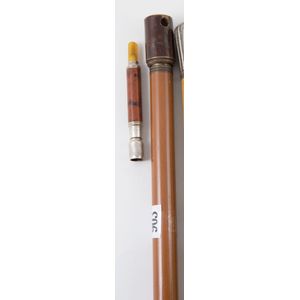
Screw-top Malacca Cane with Hidden Cheroot Holder
Malacca walking cane the screw off top revealing a cheroot holder inside

German Horn and Hoof Walking Sticks, 19th Century
Two walking sticks, horn and hoof on cane, German, 19th century, the longest 96 cm
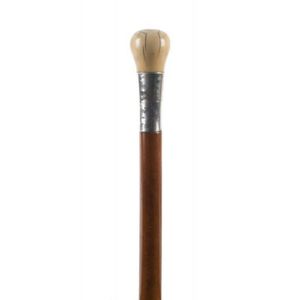
19th Century Ivory and Silver Walking Stick
A walking stick, large ivory handle with silver collar and cane shaft, 19th century, 86 cm long
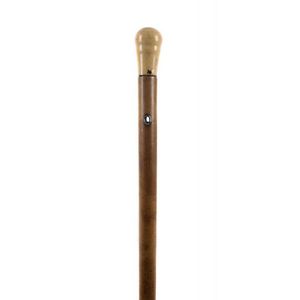
19th Century Ivory Handled Walking Stick
A walking stick, ivory handle with cane shaft, 19th century, 86 cm long

Ivory-topped 19th Century Walking Stick
A walking stick with ivory top and cane shaft, 19th century, 83 cm long

19th Century Sterling Silver and Ivory Walking Cane
A walking cane, sterling silver and ivory, 19th century, 94 cm long
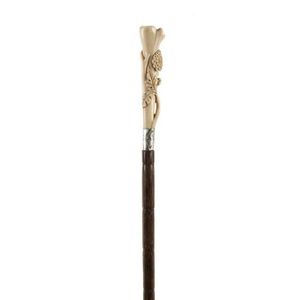
Ivory and Malacca Walking Cane - 19th Century
A walking cane, carved ivory with Malacca shaft, 19th century, 89 cm long

Telescopic Walking Cane with Sterling Silver Mounts
A sterling silver mounted walking cane with a telescopic handle, 1907 London, with maker's mark for J. Howell & Co, cane and stick, manufacturers, old Street London Ec, of classic 'T' shape, the handle with engraved silver mounts, leather, covering and an…

Assorted Canes with Unique Handles
A Colonial walking cane and a cane with a Dog's head handle, early 20th century, and later, an Indian Lucknow, style cane with a silver-plated pommel handle, relief cast with scenes of village life, and a modern brass mounted wooden stick with a striking,…
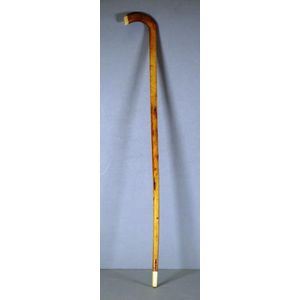
Ivory-Capped Vintage Bone Walking Cane, 82cm Length
Vintage bone walking cane with ivory capped handle and ferule., length 82 cm.

Dragon Head Ivory Cane with Ebony Shaft
A walking cane with stylised S.E. Asian dragon head finial, carved in ivory (very slight losses) fixed with a horn collar to a slender tapering ebony shaft. Length 91 cm

19th Century Ivory Greyhound Handled Walking Stick with Gold Mount
A quality 19th century carved ivory greyhound handled walking stick, glass set eyes, fine detail, the substantial later 9ct. rose gold mount with elaborate scroll engraving (17.7gm.), fitted to an old malacca cane shaft.

Ivory Egyptian Revival Walking Cane, 1810
An Egyptian revival carved ivory walking cane English, circa 1810

Antique Retriever Dog Head Walking Cane - 81cm
Antique 'retriever' dogs head walking cane, length 81 cm

Royal Scots Vintage Walking Cane with Silver Plated Handle
Vintage 'Royal Scots' walking cane, with silver plated handle, and shield (monogrammed). Length 85 cm

French Porcelain Handle Cane with Gilt Muse Decoration
A French porcelain handled cane, the tapering ebonised wood shaft terminating in a French porcelain handle decorated with one of the muses (music), embellished in gilt on a pink ground. Length 94 cm. Provenance: The Flower Family Collection.

Indian Silver Handled Malacca Cane
A Malacca and Anglo-Indian cane, the shaft terminating in a heavily embossed Indian silver handle. Length 93 cm. Provenance: The Flower Family Collection.

Ivory-handled Malacca Cane Walking Stick
An ivory handled Malacca cane walking stick, the cane shaft terminating in a turned ivory handle with a carved garter collar, the shaft with large ivory ferrule. Length 87 cm. Provenance: The Flower Family Collection.

Silver Topped Whalebone Walking Cane
A lady's silver topped whalebone walking cane, the fine tapering whalebone shaft terminating in a small silver plate collar, decoratively carved ivorine section and an engraved silver handle. Length 85 cm. Provenance: The Flower Family Collection.

Whalebone and Ivory Walking Cane
A whalebone and ivory walking cane, the shaft of alternating plain and patterned bone sections, terminating in a wide silver collar and spherical ivory handle. Length 88 cm. Provenance: The Flower Family Collection.

WMF Silver Plate Walking Cane with Deer Badge
An early 1900s walking cane, the WMF silver plate handle with restrained decoration, ostrich mark, deer hiking badge to the front, metal ferrule.

Art Nouveau Silver Walking Cane
An early 1900s walking cane, the silver handle with Art Nouveau designs, stamped 800 and maker's mark.

Bamboo-style Dog Head Walking Cane
An old horn walking cane, cylindrical sections made to simulate bamboo, threaded on a steel rod, the handle of a stylised dog's head, metal ferrule. Provenance: The Flower Family Collection. Length 84 cm

Marine Ivory Dog Head Cane
A short whalebone cane, the shaft with metal ferrule, the marine ivory handle in the form of a dog's head, glass eyes and engraved silver collar. Provenance: The Flower Family Collection. Length 66 cm

Whalebone cane with marine ivory and horn discs
A whalebone cane, the shaft with metal ferrule the top with four marine ivory discs and five horn discs, a small silver plate cartouche with dog to the front, handle absent. Provenance: The Flower Family Collection. Length 83 cm
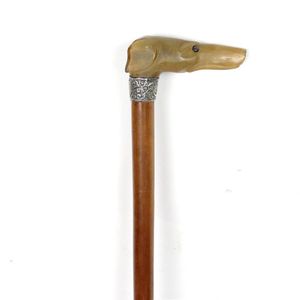
Horn Dog Head Walking Stick
A dog's head handled walking stick, the head carved from horn, mounted with a sterling silver ferrell to a malacca cane stick. Length 89 cm

19th Century Whalebone Cane, 92cm Length
A 19th century whalebone cane, plain tapering shaft, small chip to top. Length 92 cm

Antique Ivory Oriental Walking Cane Handle
Antique oriental turned ivory walking cane handle, with brass screw fitting attachment. Height 7 cm (handle only).

800 Silver Handle Vintage Walking Cane
A vintage walking cane, hardwood shaft with silver handle, stamped '800' with maker's marks.

Hazelwood Cane with Deer Antler Long-Nose Handle
A vintage walking cane, hazelwood shaft, the handle of a deer antler and carved in the form of a long-nose gentleman.

Elegant Ebonised Walking Cane with Ivory and Horn Accents
A vintage walking cane, ebonised finish, ivory collar with horn top.

Malacca Cane Walking Stick with Ivory Handle
A malacca cane and ivory handled walking stick, age crack to the handle, bone ferrule.

Antique Square Cane with Silver Mount and Armorial Engraving
An antique dark stained beech walking cane of unusual tapering square section, silver mount. London 1914 engraved with armorial.
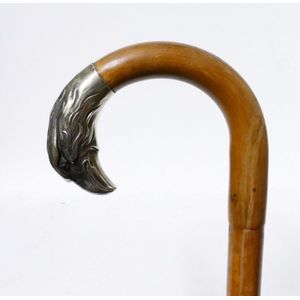
Silver-Plated Eagle Head Walking Stick
A cane walking stick, the finial surmounted by a silver-plated eagle's head with glass eyes, the stick with an alpine spike tip. Length 86 cm

1929 Engraved Vintage Walking Cane with Gold Collar
Vintage walking cane, 9 carat yellow gold collar, with engraved dedication dated 1929. Length 84 cm

Victorian Sterling Silver Monogrammed Walking Cane
Victorian silver handled walking cane, hallmarked sterling silver handle (circa 1890, marks rubbed). Monogrammed. Length 89 cm

Birmingham 1906 Silver Duck Talisman
Monty Noble's silver duck talisman (lucky charm), probably from a gentleman's walking cane, hallmarked Birmingham 1906.

M.Noble Ivory Cane Handle with Kangaroo and Lion Carvings
Gentleman's walking cane handle, carved ivory with kangaroo holding bat & lion holding ball, marked M.Noble, from M.F./ Manchester 1899'.

Silver and Rosewood Walking Cane, London 1907
Walking cane, silver mounted, rosewood stem, London, 1907, length 95 cm

Inlaid Bone Walking Cane, Length 90 cm (Cracked)
Walking cane, bone, with inlay rings, length 90 cm, (a/f crack)

Dog Head Handle for Walking Cane
Continental silver plated dog head handle, sculpted head of a dog. (possibly, a handle for a walking cane). Height 5 cm Weight 30grams

Sterling silver vintage walking cane (London 1914) - 90cm
Vintage walking cane, sterling silver hallmarked collar (London 1914). Length 90 cm

Horn & Ebony Walking Cane with Gilded Silver Decoration
Antique horn & ebony walking cane, horn handle, with gilded silver decoration (monogrammed), on ebony shaft. Length 90 cm
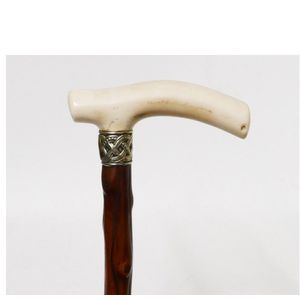
Hazelnut Cane with Ivory Handle and Silver Collar
A 19th century hazelnut walking cane, the shaft terminating in an ivory handle with a decorative silver plate collar.
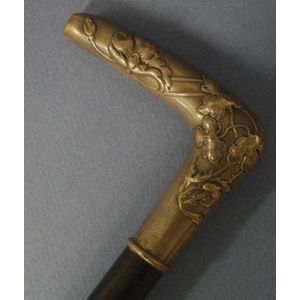
Art Nouveau Sterling Silver Walking Stick - 81cm
Sterling silver Art Nouveau cane walking stick, length 81 cm

Silver-Topped Malacca Walking Cane - 89cm Long
Silver topped Malacca walking cane, 89 cm long approx.

Burmese Deer Head Walking Cane
A Burmese walking cane with a brass handle in the form of a deer head, 19th century, 93 cm long

Georgian Ivory Greyhound Walking Cane, 19th Century
A fine Georgian walking cane with carved ivory greyhound handle and gilt metal collar, 19th century, 85 cm

Ivory and Tortoiseshell Walking Cane, 19th Century
A walking cane with ivory handle inlaid with tortoiseshell, 19th century, 82 cm

19th Century Asian Silver Topped Walking Cane
An Asian silver topped walking cane, 19th century, 89 cm

Carved Parrot Walking Cane
Antique novelty walking cane, with carved parrot form moving beak top, 76 cm long

Antique Silver Mounted Walking Cane, Stamped 'FB'
Rare C1900 silver mounted walking cane, stamped 'FB', 93 cm long

RFC Walking Cane from WWI
SES 1915 walking cane, made from the World War I Royal Flying Corps, cane knob stamped 'RFC', 89 cm long

1893 London Hallmarked Silver and Ivory Walking Cane
Sterling silver and ivory handled walking cane, hallmarked London 1893, 91 cm long.
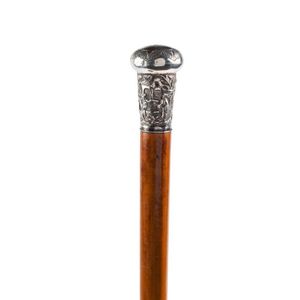
Late 19th Century Cantonese Silver Walking Cane
A Cantonese silver mounted walking cane, late 19th century, 92.5 cm

Late 19th Century Silver Mounted Walking Cane
A silver mounted walking cane, late 19th century, 83 cm


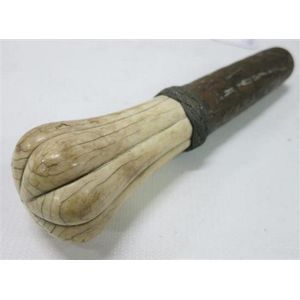



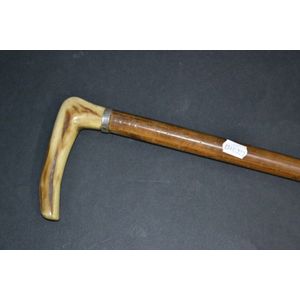

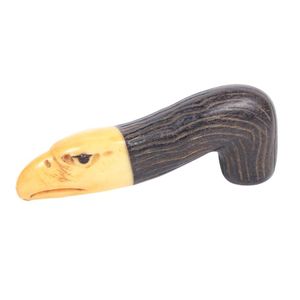


 Loading more...
Loading more...